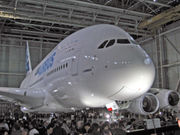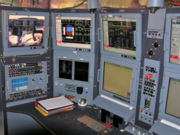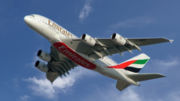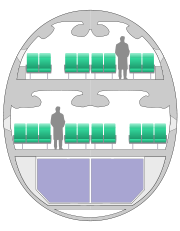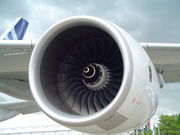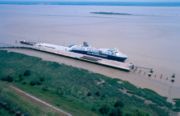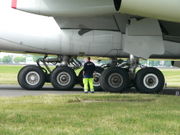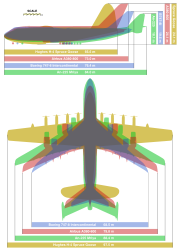Airbus A380
2007 Schools Wikipedia Selection. Related subjects: Air & Sea transport
| Airbus A380 | |
|---|---|
| Maiden flight of the A380 | |
| Type | Airliner |
| Manufacturer | Airbus S.A.S. |
| Maiden flight | 2005- 04-27 |
| Introduced | Planned for 2007 with Singapore Airlines |
| Status | In flight testing |
| Number built | Eight as of 2006 |
| Unit cost | US$ 296 - 316 million as of 2006 |
The Airbus A380 is a double-deck, four-engined airliner manufactured by Airbus S.A.S. It first flew on April 27, 2005 from Toulouse in France. Commercial flights are scheduled to begin in 2007 after lengthy delays. During much of its development phase, the aircraft was known as the Airbus A3XX. The nickname Superjumbo has become associated with the A380.
The A380's upper deck extends along the entire length of the fuselage. This allows for a spacious cabin with 50% more floor space than the next largest airliner, the Boeing 747-400, providing seating for 555 people in standard three-class configuration or up to 853 people in full economy class configuration. Two models of the A380 are available. The A380-800, the passenger model, is the largest passenger airliner in the world, superseding the Boeing 747. The other launch model, the A380-800F, will be one of the largest freight aircraft and will have a payload capacity exceeded only by the Antonov An-225.
The A380-800 has a maximum range of 15,000 kilometres (8,000 nmi, sufficient to fly from Chicago to Sydney nonstop), and a cruising speed of Mach 0.85 (about 900 km/h or 560 MPH at cruise altitude), similar to that of the Boeing 747.
History
Development
Airbus started the development of a very large airliner in the early 1990s, both to complete its own range of products and to break the dominance that Boeing had enjoyed in this market segment since the early 1970s with its 747. McDonnell Douglas pursued a similar strategy with its ultimately unsuccessful MD-12 design. As each manufacturer looked to build a successor to the 747, they knew there was room for only one new aircraft to be profitable in the 600 to 800 seat market segment. Each knew the risk of splitting such a niche market, as had been demonstrated by the simultaneous debut of the Lockheed L-1011 and the McDonnell Douglas DC-10: either aircraft met the market’s needs, but the market could profitably sustain only one model, eventually resulting in Lockheed's departure from the civil airliner business. In January 1993, Boeing and several companies in the Airbus consortium started a joint feasibility study of an aircraft known as the Very Large Commercial Transport (VLCT), aiming to form a partnership to share the limited market.
In June 1994, Airbus began developing its own very large airliner, designated the A3XX. Airbus considered several designs, including an odd side-by-side combination of two fuselages from the A340, which was Airbus’s largest jet at the time. The A3XX was pitted against the VLCT study and Boeing’s own New Large Aircraft successor to the 747, which evolved into the 747X, a stretched version of the 747 with the forebody "hump" extended rearwards to accommodate more passengers. The joint VLCT effort ended in July 1996, and Boeing suspended the 747X program in January 1997 – only to resurrect it several times before finally launching the 747-8 Intercontinental in November 2005. From 1997 to 2000, as the East Asian financial crisis darkened the market outlook, Airbus refined its design, targeting a 15 to 20 percent reduction in operating costs over the existing Boeing 747-400. The A3XX design converged on a double-decker layout that provided higher seat capacities than a traditional single-deck design.
On December 19, 2000, the supervisory board of newly restructured Airbus voted to launch a € 8.8 billion program to build the A3XX, re-christened as the A380, with 55 orders from six launch customers. The A380 designation was a break from previous sequential Airbus designations because the numeral 8 resembles the double-deck cross section, and symbolizes good luck in some Asian cultures. The aircraft’s final configuration was frozen in early 2001, and manufacturing of the first A380 wing box component started on January 23, 2002. The development cost of the A380 had grown to € 11 billion when the first aircraft was completed.
Testing
The first A380 prototype, serial number 001 and registration F-WWOW, was unveiled at a ceremony in Toulouse on January 18, 2005. Its maiden flight took place at 8:29 UTC (10:29 a.m. local time) April 27, 2005. The prototype, equipped with Trent 900 engines, departed runway 32L of Toulouse Blagnac International Airport with a flight crew of six headed by test pilot Jacques Rosay, carrying 22 short tons (20 metric tons) of flight test instrumentation and water ballasts. The take-off weight of the aircraft was 421 tonnes (464 short tons); although this was only 75% of its maximum take-off weight, it was the heaviest take-off weight of any passenger airliner ever flown.
In mid-November 2005 the A380 embarked on a tour of Southeast Asia and Australia for promotional and for long-haul flight testing purposes, visiting Singapore, Brisbane, Sydney, Melbourne and Kuala Lumpur. During this tour, the colours of Singapore Airlines, Qantas and Malaysia Airlines were applied in addition to the Airbus house colours. On November 19, an A380 flew in full Emirates colours at the Dubai Air Show.
On January 10, 2006, the A380 made its first transatlantic flight to Medellín in Colombia, to test engine performance at a high altitude airport. Its arrived in North America on February 6, when an A380 landed in Iqaluit, Nunavut in Canada for cold-weather testing. The same aircraft then flew to Singapore to participate in the Asian Aerospace 2006 exhibition, in full Singapore Airlines livery.
On March 26, 2006, the A380 underwent evacuation certification in Hamburg in Germany. The test, performed to meet regulatory requirements, involved evacuating 853 passengers and 20 crew from the aircraft within 90 seconds, with 8 of the 16 exits blocked. The evacuation was successfully completed in 78 seconds. Three days later, the A380 received European Aviation Safety Agency (EASA) and United States Federal Aviation Administration (FAA) approval to carry up to 853 passengers, indicating that the evacuation trial had met their certification standards.
Five A380s have been built for testing and demonstration purposes. The first A380 slated for delivery to a customer, serial number 003 and registration F-WWSA, took to the air in May 2006. The maiden flight of the first A380 with GP7200 engines (F-WWEA) took place on August 25, 2006.
On September 4, 2006 the first full passenger-carrying flight test took place. The aircraft flew from Toulouse with 474 Airbus employees on board, in the first of a series of flights to test passenger facilities and comfort. In November 2006, a further series of route proving flights took place to demonstrate the aircraft's performance for 150 flight hours under typical airline operating conditions.
As of November 2006, eight A380s have flown, and the five A380s in the test program have logged over 2,300 hours during 730 test flights. Airbus expects to obtain the A380 type certificate from the EASA and FAA by the end of 2006. During testing the A380 has visited 17 countries,Australia, Canada, China, Colombia, Ethiopia, France, Germany, Iceland, Ireland, Japan, Malaysia, Singapore, South Africa, South Korea, Spain,United Arab Emirates and the United Kingdom.
Delivery delays
Initial production of the A380 was plagued by a series of delays attributed to the 500 kilometres (300 miles) of wiring in each aircraft. Airbus cited as underlying causes the complexity of the cabin wiring, its concurrent design and production, the use of two incompatible versions of the CATIA computer-aided design software, the high degree of customisation for each airline, and failures of configuration management (wiring in one section will not plug correctly into wiring in another). Over 80% of the wiring is supplied by Labinal, although this company has not been blamed for the delays. Deliveries would be pushed back by nearly two years.
Airbus announced the first delay in June 2005 and notified airlines that delivery would slip by six months, with Singapore Airlines receiving the first A380 in the last quarter of 2006, Qantas getting its first delivery in April 2007 and Emirates receiving aircraft before 2008. This reduced the number of planned deliveries by the end of 2009 from about 120 to 90-100.
On June 13, 2006 Airbus announced a second delay, with the delivery schedule undergoing an additional shift of six to seven months. Although the first delivery was still slated before the end of 2006, deliveries in 2007 would drop to only 9 aircraft, and deliveries by the end of 2009 would be cut to 70-80 aircraft. The announcement caused a 26% drop in the share price of Airbus's parent, EADS, and led to the departure of EADS CEO Noël Forgeard, Airbus CEO Gustav Humbert, and A380 program manager Charles Champion. In the wake of the new delay, Malaysia Airlines and ILFC were reported to be considering the cancellation of their orders. Launch customers Singapore Airlines, Emirates and Qantas also were reported to be angered by the delays and expecting compensation. However, on July 21, 2006 Singapore Airlines ordered a further 9 A380s and stated that Airbus had "demonstrated to our satisfaction that the engineering design for the A380 is sound [and that] it has performed well in flight and certification tests and the delays in its delivery have been caused more by production, rather than technical, issues."
On October 3, 2006, upon completion of a review of the A380 program, the new CEO of Airbus, Christian Streiff, announced a third delay. The largest delay yet, it pushed the first delivery for Singapore Airlines to October 2007, to be followed by 13 deliveries in 2008, 25 in 2009, and the full production rate of 45 aircraft per year in 2010. The delay also increased the earnings shortfall projected by Airbus through 2010 to € 4.8 billion. The customer with the largest A380 order, Emirates, saw its first delivery pushed back to August 2008 and said as a result that it was considering scaling back its order, potentially in favour of the rival Boeing 747-8. Virgin Atlantic deferred its deliveries by four years, to 2013. Initial deliveries for the A380 freighter were delayed into 2010. The third delay was followed by the first cancellation to hit the A380 program, as FedEx dropped its order for ten A380F freighters in favour of 15 Boeing 777F freighters.
Entry into service
Singapore Airlines plans to use its first aircraft, in a 485-seat configuration, on its London–Singapore–Sydney (the kangaroo route) service. Subsequent routes for Singapore Airlines may include the Singapore– San Francisco route via Hong Kong, as well as direct flights to Paris and Frankfurt. Qantas has announced it will use the A380, in a 501-seat configuration, on its Melbourne and Sydney to Los Angeles routes. Air France's aircraft will be used on the Paris to Montreal and New York routes.
Design
The new Airbus is sold in two models. The A380-800 can carry 555 passengers in a three-class configuration or up to 853 passengers in a single-class economy configuration. The range for the -800 model is 15,000 kilometres (8,000 nmi). The second model, the A380-800F freighter, will carry 150 tonnes of cargo 10,400 km (5,600 nmi).
Future variants may include an A380-900 stretch seating about 650 passengers, a shortened A380-700 seating about 455 passengers, and an extended range version with the same passenger capacity as the A380-800. The A380's wing is sized for a Maximum Take-Off Weight (MTOW) over 650 metric tonnes in order to accommodate these future versions, albeit with some strengthening required. The stronger wing (and structure) is used on the A380-800F freighter. This common design approach sacrifices some fuel efficiency on the A380-800 passenger model, but the sheer size of the aircraft, coupled with the significant advances in technology described below, are still expected to provide lower operating costs per passenger than all current 747 variants.
Cockpit
Airbus used similar cockpit layout, procedures and handling characteristics to those of other Airbus aircraft, to reduce crew training costs. Accordingly, the A380 features an improved glass cockpit, and fly-by-wire flight controls linked to side-sticks.
The improved cockpit displays feature eight 15-by-20 cm (6-by-8-inch) liquid crystal displays, all of which are physically identical and interchangeable. These comprise two Primary Flight Displays, two navigation displays, one engine parameter display, one system display and two Multi-Function Displays. These MFDs are new with the A380, and provide an easy-to-use interface to the flight management system—replacing three multifunction control and display units. They include QWERTY keyboards and trackballs, interfacing with a graphical " point-and-click" display navigation system.
Engines
Either the Rolls-Royce Trent 900 or Engine Alliance GP7200 turbofans may power the A380. Both are derived from predecessors ( GE90 and Trent 800) available on the Boeing 777. The Trent 900 is the scaled version of the Trent 800, but incorporating the swept-back fan and counter-rotating spools of the stillborn Trent 8107. The GP7200 has a GE90-derived core and PW4090-derived fan and low-pressure turbo-machinery. Noise reduction was a driving requirement for the A380, and particularly affects engine design. Both engine types meet the stringent QC/2 departure noise limits set by London's Heathrow Airport, which is expected to become a key destination for the A380.
Advanced materials
Composite materials make up 25% of the A380's airframe, by weight. Carbon-fibre reinforced plastic, glass-fibre reinforced plastic and quartz-fibre reinforced plastic are used extensively in wings, fuselage sections, tail surfaces, and doors. The A380 is the first commercial airliner with a central wing box made of carbon fibre reinforced plastic, and it is the first to have a wing cross-section that is smoothly contoured. Other commercial airliners have wings that are partitioned in sections. The flowing, continuous cross-section allows for maximum aerodynamic efficiency. Thermoplastics are used in the leading edges of the slats. The new material GLARE (GLAss-REinforced fibre metal laminate) is used in the upper fuselage and on the stabilizers' leading edges. This aluminium-glass-fibre laminate is lighter and has better corrosion and impact resistance than conventional aluminium alloys used in aviation. Unlike earlier composite materials, it can be repaired using conventional aluminium repair techniques.
Newer weldable aluminium alloys are also used. This enables the widespread use of laser welding manufacturing techniques - eliminating rows of rivets and resulting in a lighter, stronger structure.
Avionics architecture
The A380 employs an Integrated Modular Avionics (IMA) architecture, first used in advanced military aircraft such as the F-22 Raptor and the Eurofighter Typhoon. It is based on a commercial off-the-shelf (COTS) design. Many previous dedicated single-purpose avionics computers are replaced by dedicated software housed in onboard processor modules and servers. This cuts the number of parts, provides increased flexibility without resorting to customised avionics, and reduces costs by using commercially available computing power.
Together with IMA, the A380 avionics are very highly networked. The data communication networks use Avionics Full-Duplex Switched Ethernet, following the ARINC 664 standard. The data networks are switched full-duplexed star-topology and based on 100baseTX fast-Ethernet. This reduces the amount of wiring required and minimizes latency.
The Network Systems Server (NSS) is the heart of A380 paperless cockpit. It eliminates the bulky manuals and charts traditionally carried by the pilots. The NSS has enough inbuilt robustness to do away with onboard backup paper documents. The A380's network and server system stores data and offers electronic documentation, providing a required equipment list, navigation charts, performance calculations, and an aircraft logbook. All are accessible to the pilot from two additional 27 cm (11 inch) diagonal LCDs, each controlled by its own keyboard and control cursor device mounted in the foldable table in front of each pilot.
Systems
Power-by-wire flight control actuators are used for the first time in civil service, backing up the primary hydraulic flight control actuators. During certain manoeuvres, they augment the primary actuators. They have self-contained hydraulic and electrical power supplies. They are used as electro-hydrostatic actuators (EHA) in the aileron and elevator, and as electrical backup hydrostatic actuators (EBHA) for the rudder and some spoilers.
The aircraft's 350 bar (35 MPa or 5,000 psi) hydraulic system is an improvement over the typical 210 bar (21 MPa or 3,000 psi) system found in other commercial aircraft since the 1940s. First used in military aircraft, higher pressure hydraulics reduce the size of pipelines, actuators and other components for overall weight reduction. The 350 bar pressure is generated by eight de-clutchable hydraulic pumps. Pipelines are typically made from titanium and the system features both fuel and air-cooled heat exchangers. The hydraulics system architecture also differs significantly from other airliners. Self-contained electrically powered hydraulic power packs, instead of a secondary hydraulic system, are the backups for the primary systems. This saves weight and reduces maintenance.
The A380 uses four 150 kVA variable-frequency electrical generators eliminating the constant speed drives for better reliability. The A380 uses aluminium power cables instead of copper for greater weight savings due to the number of cables used for an aircraft of this size and complexity. The electrical power system is fully computerized and many contactors and breakers have been replaced by solid-state devices for better performance and increased reliability.
The A380 features a bulbless illumination system. LEDs are employed in the cabin, cockpit, cargo and other fuselage areas. The cabin lighting features programmable multi-spectral LEDs capable of creating a cabin ambience simulating daylight, night or shades in between. On the outside of the aircraft, HID lighting is used to give brighter, whiter and better quality illumination. These two bulbless technologies provide brightness and a service life superior to traditional incandescent light bulbs.
The A380 was initially planned without thrust reversers, as Airbus believed it to have ample braking capacity. The FAA disagreed, and Airbus elected to fit only the two inboard engines with them. The two outboard engines do not go into reverse, to reduce the amount of debris blown up during landing. The A380 features electrically actuated thrust reversers, giving them better reliability than their pneumatic or hydraulic equivalents, in addition to saving weight.
Passenger amenities
Initial publicity stressed the comfort and space of the A380's cabin, which offers room for such installations as relaxation areas, bars, duty-free shops, and beauty salons. One A380 customer likely to use innovative amenities is Virgin Atlantic Airways, which has a bar in Business Class on its aircraft, and has announced plans to include casinos, double beds, a gymnasium and showers on its A380s.
The A380 will expand the improvements that the 747 made — more seats and lower seat-distance costs — while providing wider seats and better amenities. At 555 passengers, the A380's seating capacity represents a 35% increase over the 747-400 in a standard three-class configuration, along with a nearly 50% larger cabin volume — producing more space per passenger. If, however, the plane is ordered in an all-economy-class configuration, it can hold up to 853 passengers, its maximum certified carrying capacity.
Airport compatibility
The A380 was designed to fit within an 80 x 80 m airport gate, and can land or take off on any runway that can take a Boeing 747. However, airports used by the A380 in commercial service may need infrastructure modifications. Its large wingspan can require some taxiway and apron reconfigurations, to maintain safe separation margins when two of the aircraft pass each other. Taxiway shoulders may be required to be paved to reduce the likelihood of foreign object damage caused to (or by) the outboard engines, which overhang more than 25 m (80 ft) from the centre line of the aircraft. Any taxiway or runway bridge must be capable of supporting the A380's maximum weight. The terminal gate must be sized such that the A380's wings do not block adjacent gates, and may also provide multiple jetway bridges for simultaneous boarding on both decks. Service vehicles with lifts capable of reaching the upper deck must be obtained, as well as tractors capable of handling the A380's maximum ramp weight.
The A380 test aircraft have begun a campaign of airport compatibility testing, to verify the modifications already made at several large airports. To date, the airports visited for compatibility testing include Brisbane, Frankfurt, Hong Kong, Johannesburg, Tokyo Narita, Kuala Lumpur, London Heathrow, Melbourne, Singapore, and Sydney.
Production
Major structural sections of the A380 are built in France, Germany, Spain, and the United Kingdom. Due to their size, they are brought to the assembly hall in Toulouse in France by surface transportation, rather than by the Beluga aircraft used for other Airbus models. Components of the A380 are provided by suppliers from around the world; the five largest contributors, by value, are Rolls-Royce, SAFRAN, United Technologies, General Electric, and Goodrich.
The front and rear sections of the fuselage are loaded on an Airbus RORO ship, Ville de Bordeaux, in Hamburg in northern Germany, whence they are shipped to the United Kingdom. The wings, which are manufactured at Filton in Bristol and Broughton in north Wales, are transported by barge to Mostyn docks, where the ship adds them to its cargo. In Saint-Nazaire in western France, the ship trades the fuselage sections from Hamburg for larger, assembled sections, some of which include the nose. The ship unloads in Bordeaux. Afterwards, the ship picks up the belly and tail sections by Construcciones Aeronáuticas SA in Cadiz in southern Spain, and delivers them to Bordeaux. From there, the A380 parts are transported by barge to Langon, and by oversize road convoys to the assembly hall in Toulouse. New wider roads, canal systems and barges were developed to deliver the A380 parts. After assembly, the aircraft are flown to Hamburg to be furnished and painted. Airbus sized the production facilities and supply chain for a production rate of four A380s per month.
Orders
Sixteen airlines have ordered the A380, including an order from aircraft lessor ILFC. A380 orders stand at 166, of which 157 are firm and 15 are freighter models. Airbus expects to sell a total of 750 aircraft, and estimates break-even at 420 units, increased from 270 due to delivery delays and the falling exchange rate of the US dollar. Industry analysts anticipate between 400 and 880 sales by 2025. As of 2006, the unit cost of the A380 is US$ 296 to 316 million, depending on equipment installed.
Entries shaded in pink have been announced, but have not yet signed a firm contract.
Technical concerns
Several concerns about the A380 have arisen. Airbus has said that it will address these concerns as required by the European Aviation Safety Agency and its American counterpart, the FAA, which must both issue a type certificate before the A380 can enter into service.
Ground operations
Early critics claimed that the A380 would damage taxiways and other airport surfaces. However, the pressure exerted by its wheels is lower than that of a Boeing 747 or Boeing 777 because the A380 has 22 wheels, four more than the 747, and eight more than the 777. Airbus measured pavement loads using a 540-tonne (595 short tons) ballasted test rig, designed to replicate the landing gear of the A380. The rig was towed over a section of pavement at Airbus' facilities that had been specially instrumented with embedded load sensors.
Based on its wingspan, the American FAA classifies the A380 as a Design Group VI aircraft, requiring a width of 60 m (200 ft) for runways and 30 m (100 ft) for taxiways, compared to 45 m (150 ft) and 23 m (75 ft) for Design Group V aircraft such as the Boeing 747. Airbus claimed that the A380 could safely operate on Group V runways and taxiways, without the need for widening. The FAA first considered limiting the taxiing speed of the A380 to 25 km/h (15 mph) on Group V infrastructure, but has since issued waivers that do away with the speed restriction and some runway widening requirements.
As of late 2005 there were concerns that the jet blast from the A380's engines could be dangerous to ground vehicles and airport terminal buildings, as more thrust is required to move its greater mass (590 t compared to 412.8 t for a 747). The FAA has established a commission to determine if new safety regulations seem necessary, and will make appropriate recommendations to the ICAO. According to The Wall Street Journal, "The debate is supposed to be entirely about safety, but industry officials and even some participants acknowledge that, at the very least, an overlay of diplomatic and trade tensions complicates matters." The FAA commission has stated it will not enact unilateral safeguards for the A380, only those imposed by the ICAO.
Wake turbulence
The A380 generates more wake turbulence on takeoff and landing than existing aircraft types, requiring increased airport approach and departure spacing for following aircraft.
In 2005, the International Civil Aviation Organization recommended that provisional separation criteria for the A380 be substantially greater than for the 747 because preliminary flight test data suggested a stronger wake than the 747. These criteria were in effect while the A380 Wake Vortex Steering Group, with representatives from the JAA, Eurocontrol, the FAA and Airbus, refined its 3-year study of the issue with additional flight testing. In September 2006, the working group presented its conclusions to the ICAO, which is expected to issue final guidance on the issue in November 2006.
The working group concluded that an aircraft trailing an A380 during approach needs to maintain a separation of 6 nm, 8 nm and 10 nm respectively for ICAO "Heavy", "Medium" and "Light" aircraft categories, instead of the traditional 4 nm, 5 nm and 6 nm spacing. However, the working group found no need to limit the A380's trailing distance behind another aircraft, potentially making up for some of the increased spacing behind the A380. On departure behind an A380, the working group concluded that "Heavy" aircraft are required to wait two minutes, and "Medium"/"Light" aircraft three minutes for time based operations. Finally, the working group did not recommend any restrictions on vertical or horizontal separation criteria during cruise.
Wing strength
During the destructive wing strength certification test, the test wing of the A380 failed to meet the certification requirement of 150% of limit load. Limit load is the maximum load expected during operation in the design life of an aircraft. The test wing buckled between the inboard and outboard engines at 147% of limit load, as the wing tip reached a vertical deflection of 7.4 m (24.3 ft). Airbus initially stated that the test article represented an early design, and that the load requirement would be verified by analysis of changes already made. Subsequently, however, Airbus announced that modifications adding 30 kg to the wing would be made to provide the required strength.
Cabin pressurization
Joseph Mangan, a former employee of TTTech, has claimed the microprocessors produced by TTTech for the A380 are severely flawed. The microchips control the A380's cabin pressurization system; Mangan has stated that the combination of TTTech's microprocessor and a new architecture of valves could cause the A380 to undergo rapid decompression. This sudden drop in cabin pressure could cause the flight crew to lose consciousness and jeopardize safe flight. This allegation has been strongly rejected by both TTTech and Airbus parent EADS. Boeing has also said it is unaware of any problems with TTTech's chips. An Austrian court has fined Mr. Mangan for violating its preliminary injunction against discussing his allegations pending court cases.
Trivia
- The A380 was nicknamed "Megaliner" during early development within Airbus.
- Each A380 contains 530 kilometres (330 miles) of cables, 100,000 wires, and 40,300 connectors.
- Acclaimed film director Martin Scorsese is making a documentary film about the creation of the A380.
- The fictional aircraft (the E-474) in the 2005 film Flightplan clearly resembles an A380 in its general arrangement of full length upper and lower passenger decks and four turbofan engines. The number is obviously derived from the Boeing 747. The nose, however, resembles the McDonnell Douglas MD-12.
- Likewise, the experimental "Skyfleet" prototype plane from Casino Royale is also based on the A380.
Specifications
| Measurement | A380-800 | A380F |
|---|---|---|
| Cockpit crew | Two | Two |
| Seating capacity | 555 (3-class) | 12 couriers |
| Length | 73 m (239 ft 6 in) | 73 m (239 ft 6 in) |
| Span | 79.8 m (261 ft 10 in) | 79.8 m (261 ft 10 in) |
| Height | 24.1 m (79 ft 1 in) | 24.1 m (79 ft 1 in) |
| Wheelbase | 30.4 m (99 ft 8 in) | 30.4 m (99 ft 8 in) |
| Outside fuselage width | 7.14 m (23 ft 6 in) | 7.14 m (23 ft 6 in) |
| Floor width, main deck | 6.30 m (20 ft 8 in) | 6.30 m (20 ft 8 in) |
| Floor width, upper deck | 5.28 m (17 ft 4 in) | 5.28 m (17 ft 4 in) |
| Wing area | 845 m² (9,100 ft²) | 845 m² (9,100 ft²) |
| Operating empty weight | 276,800 kg (610,200 lb) | 252,200 kg (556,000 lb) |
| Maximum take-off weight | 560,000 kg (1,235,000 lb) | 590,000 kg (1,300,000 lb) |
| Maximum payload | 90,800 kg (200,000 lb) | 152,400 kg (336,000 lb) |
| Cruising speed | 0.85 Mach | 0.85 Mach |
| Maximum speed | 0.89 Mach | 0.89 Mach |
| Range at design load | 8,000 nm (15,000 km) | 5,600 nm (10,400 km) |
| Maximum fuel capacity | 310,000 L (81,890 U.S. gallons) | 310,000 L (81,890 U.S. gallons), 356,000 L (94,000 U.S. gallons) option |
| Engines | 4 x GP7270 or Trent 970 | 4 x GP7277 or Trent 977 |

